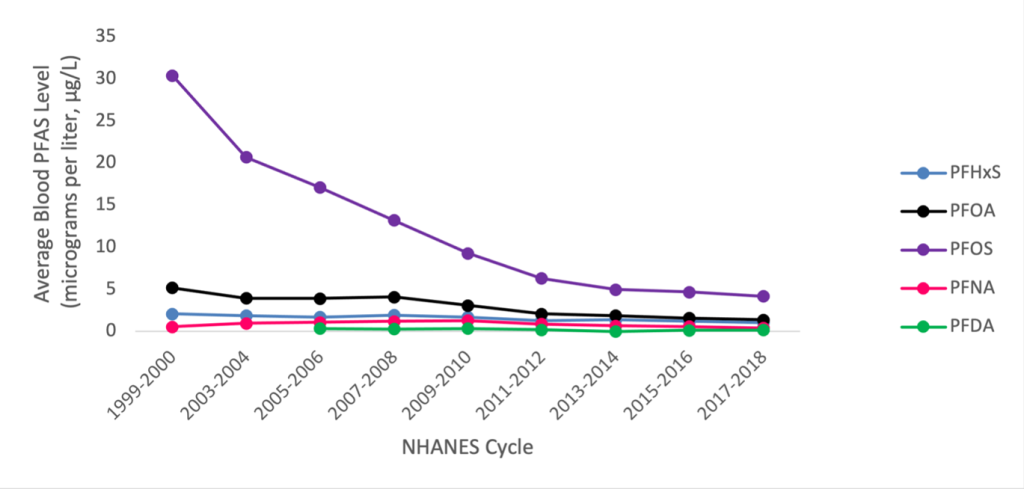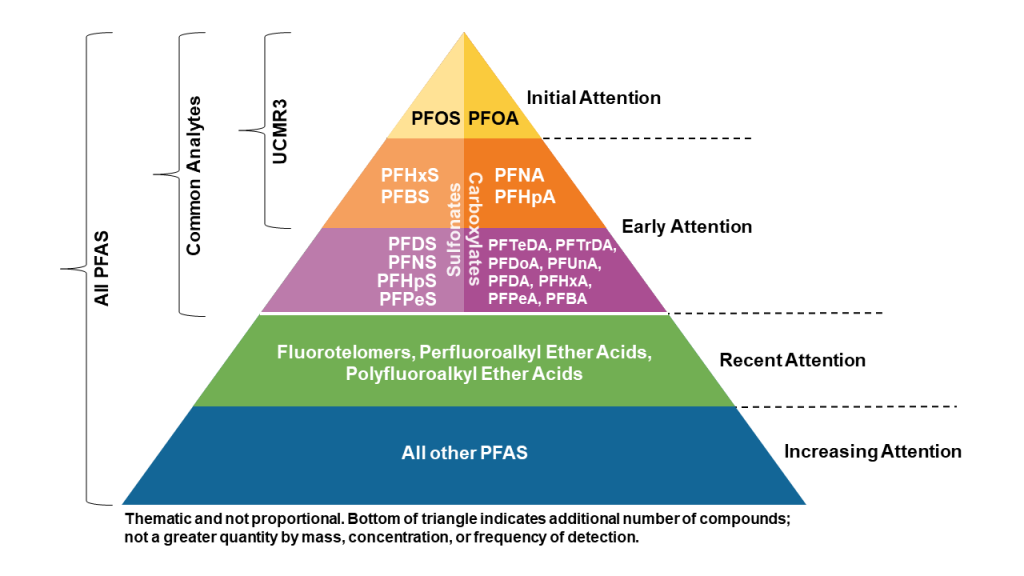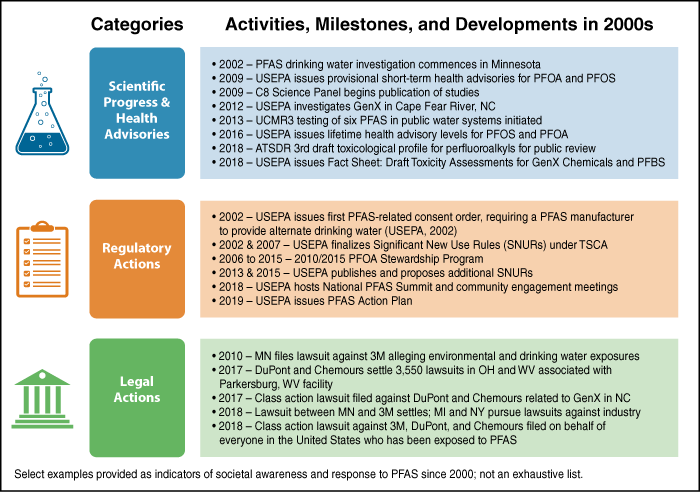2.3 Emerging Health and Environmental Concerns
Like other emerging contaminants, knowledge and concern about PFAS in the environment have evolved through a series of phases discussed in this section:
- discovery and/or synthesis of PFAS (Section 2.2.5), followed by growth in commercial production and use (Section 2.5)
- emerging health and environmental concerns, including:
- awareness of potential health impacts (Section 2.3.1)
- analytical developments (Section 2.3.2)
- detection in the environment (Section 2.3.3)
- growing awareness and concern (Section 2.3.4)
- subsequent efforts to reduce use of contaminants of concern and/or replace the contaminants of concern with alternate technologies and chemicals, accompanied by health and environmental questions about those chemicals (Section 2.4)
2.3.1 Awareness of Potential Health Impacts
Occupational studies in the 1970s found detections of some PFAS in the blood of exposed workers, and further studies in the 1990s reported detections in the blood of the general human population (Buck et al. 2011). In recent years, the presence of several long-chain PFAAs (PFOA, PFOS, PFNA, and PFHxS) have been measured in the low parts per billion (ppb, equivalent to nanograms per milliliter (ng/ml)) range in the blood serum of almost all residents of the United States and other industrialized nations (Kato and Calafat 2015; CDC 2022). These PFAS are present whether or not people were exposed in the workplace, likely due to the widespread use of PFAS in consumer products and industries (Kannan et al. 2004; Kärrman et al. 2006; Olsen et al. 2003). However, there have been decreasing concentrations of long-chain PFAAs in people’s blood serum, likely due to the voluntary reductions in production, especially PFOA and PFOS; refer to the CDC data presented below. Further information and discussion of studies and human health effects can be found in Section 7.1.
| Unit | Mass per liter (L) | Mass per milliliter (mL) |
|---|---|---|
| 1 part per million (ppm) | 1 mg/L | 1 µg/mL |
| 1 part per billion (ppb) | 1 µg/L | 1 ng/mL |
| 1 part per trillion (ppt) | 1 ng/L | 1 pg/mL |
mg = milligrams, µg = micrograms, ng = nanograms, pg = picograms
1 ppm = 1,000 ppb = 1,000,000 ppt
These findings led to increased awareness of PFAAs in the environment, associated human exposure, and the potential for health effects. Occupational workers may be more highly exposed, and at risk, than other populations (ATSDR 2018). Laboratory studies using animals and epidemiological studies of human populations show that exposure to some PFAS may be associated with a wide range of adverse human health effects ( USEPA 2016; USEPA 2016; ASTDR 2021). Toxicity studies have mostly focused on PFOS and PFOA, as well as some other long-chain PFAAs (Section 7.1). More recently, the toxicology of other PFAS, such as fluorotelomers and shorter chain PFAAs, as well as replacement PFAS chemicals (such as GenX chemicals, Section 2.4.6), have received increased attention (CONCAWE 2016; USEPA 2016; USEPA 2021).
ATSDR is undertaking a national, multi-site PFAS health study to evaluate the health impacts of PFAS in drinking water (ATSDR 2020). The study was authorized by the National Defense Authorization Acts of 2018 and 2019. According to ATSDR, “The information learned from the multi-site study will help all communities in the U.S. with PFAS exposures, including those that were not part of the study.” The multi-site health study builds on the Pease Health Study at former Pease Air Force Base in Newington, NH, which effectively serves as a pilot program. The health study is intended to provide a better understanding of the cause and effect relationship between PFAS at various concentration and specific health outcomes based on adults and children. The study is expected to improve upon epidemiological studies with limited information about exposure factors.
In addition to the PFAS health study, ATSDR conducted PFAS Exposure Assessments at 10 locations in the United States. The 10 locations selected had PFOA and PFOS in the public drinking water that had previously exceeded the EPA 2016 health advisory level of 70 ng/L and/or other state guidelines. Through the Exposure Assessments, ATSDR was able to estimate exposures to PFAS in these communities and compare those exposure estimates to measured levels in blood collected from participants. Results of these Exposure Assessments are published in ATSDR’s Final Report (ATSDR 2022).
The Centers for Disease Control (CDC) has been including biomonitoring for specific PFAS in blood serum in its National Health and Nutrition Examination Survey (NHANES) surveys of the U.S. general population since 1999-2000, and the latest NHANES PFAS data are from 2017-18 (CDC 2022). Blood serum levels of some PFAS in NHANES monitoring have decreased over time, as shown in Figure 2-17.

Figure 2-17. Blood Serum Levels of Specific PFAS Frequently Detected in the U.S. General Population (NHANES) Over Time (data from CDC 2022)
2.3.2 Analytical Developments
Early detection of PFAS in environmental media was hindered by the analytical capability challenges arising from the unique surface-active properties of PFAS (Giesy and Kannan 2001; 3M Company 2000). Since the 2000s, methods have been, and continue to be, developed with lower detection limits (for example, parts per trillion [ppt]) in water, that are commensurate with levels of potential human health effects. The number of commercial laboratories that offer PFAS analysis is increasing. Analytical methods continue to be developed and improved to test a variety of media and additional PFAS; these continue to improve our knowledge of PFAS in the environment and potential human health effects.
Since the early 2000s, three analytical methods have been developed, validated, and published by USEPA for the analysis of PFAS in drinking water. These include Methods 537, 537.1, and 533 (USEPA 2020). These methods were developed for finished drinking water from groundwater and surface water sources. According to USEPA, these methods were developed for accuracy, precision, and robustness and have been through multi-lab validation and peer review (see Section 11). USEPA notes that Method 537 was used extensively during Unregulated Contaminant Monitoring Rule 3, described above. In December 2019, USEPA published Method 533: Determination of Per- and Polyfluoroalkyl Substances in Drinking Water by Isotope Dilution Anion Exchange Solid Phase Extraction and Liquid Chromatography/Tandem Mass Spectrometry (USEPA 2019). While each method includes analytes not included in the other, the analytes targeted by Method 533 include shorter-chain PFAS and fluorotelomers (see Section 11.2.1.1). Methods 537.1 and 533 have both been validated for the analysis of HFPO-DA (a component of the GenX processing aid technology). The PFAS analytes associated with Methods 537.1 and 533 are listed in Table 2-5 (separate PDF) and categorized according to the family tree hierarchy. The USEPA has also published the draft USEPA Method 1633 that tests for up to 40 PFAS in eight environmental media (USEPA 2023). For further information on USEPA analytical methods, refer to Section 11.
The number of PFAS that can be identified and quantified by analysis has also evolved over time, with longer lists of compounds and changing commercial availability linked to evolving health and environmental concerns. Early focus was on PFOA and PFOS, but nationwide testing of drinking water supplies under the USEPA’s Third Unregulated Contaminant Monitoring Rule (UCMR3) led to four additional PFAAs (PFHpA, PFNA, PFBS, PFHxS) gaining greater attention. More information about UCMR3 is provided in Section 6.3, and a summary of the occurrence data for the six PFAAs analyzed during UCMR3 is provided in Section 8.2. UCMR5 is planned for in 2023–2025 and includes 29 PFAS using USEPA Methods 533 and 537.1. UCMR5 includes all large systems serving over 10,000 people, all small systems serving 3,300 to 10,000 people, and 800 randomly selected small systems serving less than 3,300 people (USEPA 2021).
Many state regulatory agencies now request or require testing for an expanded list of long- and short-chain PFAAs, and some potential precursors to PFAAs, such as fluorotelomers. Other polyfluoroalkyl substances are also receiving increased attention, as illustrated in Figure 2-18. Many of these PFAS are also summarized in Figure 2-6.
Other analytical methods and approaches are available to detect and quantify PFAS not included in the standard methods mentioned above, including nontarget analysis, total organic fluorine, and total oxidizable precursor assay (see Section 11).
Figure 2-18. Emerging awareness and emphasis on PFAS occurrence in the environment
Source: J. Hale, Kleinfelder. Used with permission.
2.3.3 Detection in the Environment
Although some PFAS have been manufactured since the 1950s, PFAS were not widely documented in environmental samples until the early 2000s, as PFAS testing was not widely available until that time. Since the early 2000s, however, the occurrence of PFAS in the environment has been a very active area of research. The occurrence of certain PFAS has been reported in a wide variety of matrices, including sediments, surface and groundwater, and wildlife (Kannan et al. 2004; Yamashita et al. 2005; Higgins et al. 2007; Rankin et al. 2016). As noted above, UCMR3 sampling detected PFAS in 4% of drinking water supplies across the country, including in 33 states, three territories, and one Native American community (Hu et al. 2016). However, the Hu et al. study used a non-final download of the UCMR3 dataset, so final statistics may be different. Initially, investigations focused mainly on major releases from manufacturing sources and significant PFAS uses such as firefighting foam application sites.
In recent years, with more sensitive analytical methods available, studies have detected PFAS (especially PFAAs) in locations throughout the globe, even in areas well beyond where they were initially used or manufactured (Houde et al. 2011). Detections of certain PFAS in the environment in various media are detailed in Section 6, and ecological effects are described in Section 7.2.
2.3.4 Growing Awareness and Concern
Societal awareness and concern about PFAS have increased since regulatory activity began in the early 2000s. Societal awareness and response are documented in the form of scientific progress and health advisories, regulatory actions, and legal actions. Major milestones for these activities within the United States are summarized in Figure 2-19. Other milestones, such as the growth of knowledge and investigation at major manufacturing and DOD sites in various U.S. states, are not discussed here.
Figure 2-19. Growing awareness and concern 2000-2019.
Updated September 2023.




